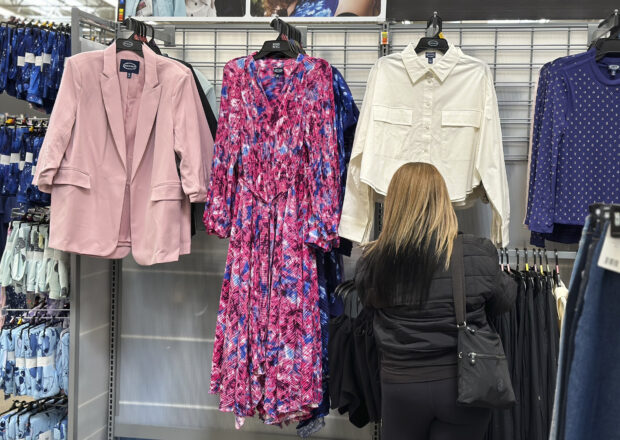
A shopper looks at clothes at a Walmart store in Secaucus, N.J., on March 25, 2024. On Monday, April 15, 2024, the Commerce Department releases U.S. retail sales data for March (AP Photo/Anne D’Innocenzio)
NEW YORK — Americans boosted spending at a hotter-than-expected pace in March, underscoring how shoppers remain resilient despite inflationary pressures and other economic challenges.
Retail sales rose 0.7 percent last month — almost double what economists had forecast — after rising 0.9 percent in February, according to Commerce Department data released Monday.
The February figure was revised upward. That comes after sales fell 1.1 percent in January, dragged down in part by inclement weather. Excluding gas prices, which have been on the rise, retail sales still rose a solid at 0.6 percent.
The national average gas price Monday was $3.63 per gallon, per AAA, up 6 cents from a week ago, and up 19 cents from last month, but they’re still 3 cents below where they were at this point last year.
The snapshot offers only a partial look at consumer spending and doesn’t include many services, including travel and hotel lodges. But the lone services category – restaurants – registered an uptick of 0.4 percent.
Government retail data isn’t adjusted for inflation, which ticked up 0.4 percent from February to March, according to the latest government report. So retailers had a solid sales gain accounting for inflation.
READ: US consumer inflation accelerated in March, dampening rate cut hopes
“Retail sales aren’t increasing just because prices are going up,” said Ted Rossman, senior industry analyst at Bankrate. “Americans are actually buying more stuff. This is one of the strongest retail sales reports we’ve seen in the past couple of years.”
Strong job market, rising wages
Futures jumped seconds after the retail report landed, while bond prices slipped given the strong economic signals that the U.S. consumer is sending.
Sales at general merchandise stores rose 1.1 percent, while online sales were up 2.7 percent. Department stores had a 1.1-percent decline. Furniture stores and electronics and appliance stores also posted sales declines.
A strong jobs market and rising wages have fueled household spending, which also has become choppy in the face of rising credit costs and higher prices.
America’s employers delivered another strong report in March, adding 303,000 workers to their payrolls and fueling hopes that the economy can plow through higher prices without succumbing to a recession despite high-interest rates.
Last month’s job growth rose from a revised 270,000 in February and far exceeded the 200,000 jobs that economists had predicted. By any measure, it amounted to a major burst of hiring, and it underscored the economy’s ability to withstand the pressure of high borrowing costs resulting from the Federal Reserve’s interest rate hikes. With Americans continuing to spend, many companies have continued hiring to meet steady demand.
READ: Another month of robust US job growth points to continued economic strength
However, inflation has remained stubborn, lifted last month by higher prices for gasoline, rents, auto insurance, and other items, new data showed last week.
No rate cut until September
That as well as the strong retail sales report will likely delay a cut by the Federal Reserve to interest rates that many had anticipated at the next meeting of the U.S. Federal Reserve’s monetary policy-making arm in a couple of weeks.
Andrew Hunter, deputy chief U.S. economist at Capital Economics, doesn’t think any rate cut will happen until September.
READ: Inflation frustration may prompt Fed to dial back rate-cut outlook
Prices outside the volatile food and energy categories rose 0.4 percent from February to March, the same accelerated pace as in the previous month. Measured from a year earlier, these core prices are up 3.8 percent, unchanged from the year-over-year rise in February. The Fed closely tracks core prices because they tend to provide a good barometer of where inflation is headed.
Some economists, however, expect spending to moderate due to lessening optimism about economic prospects, still high costs of living, and elevated borrowing costs.
“Consumers are becoming highly selective in their spending choices with many pulling back from pricier, non-discretionary products to focus on value and essentials and the lower-income cohort continues to be pressured, ” said Mickey Chadha, Moody’s Ratings vice president of corporate finance. “Purposeful consumers are postponing their major shopping decisions. ”